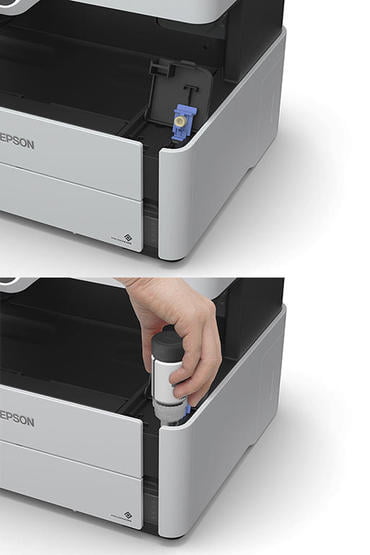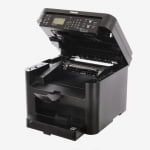Predictions of the ‘paperless office’ have been around for decades, but although email and electronic document formats — such as Adobe’s PDF — are widely used, printing stubbornly remains a significant cost for many businesses. It’s also well known that printer manufacturers generally make most of their profit not from the cost of the printers themselves, but from sales of replacement ink and toner cartridges.
These cartridges have been a cash cow for printer manufacturers for many years, but more affordable and sustainable printing technologies are now finding their way into the workplace.

Images: Epson
Back in 2014, Epson launched the first of a new range of EcoTank inkjet printers, based on a new ‘cartridge-free’ printing technology. The initial purchase price of the EcoTank printers was considerably higher than that of conventional inkjet devices, but rather than using traditional ink cartridges, the printers had a large internal ink ‘tank’ that could easily be refilled using low-cost bottles of ink.
These bottles also hold enough ink to print thousands of pages before needing to refill the printer, drastically reducing the cost-per-page for printing documents and reducing the total cost of ownership over the printer’s lifetime. The empty bottles of ink were also easier to recycle — hence the ‘EcoTank’ label.
In the tank
The early EcoTank printers were still quite slow, so Epson primarily concentrated on promoting them to environmentally-conscious home users, rather than busy corporate workgroups. However, Epson has recently launched a new range of EcoTank Monochromeprinters in Europe and Asia, that are designed to provide an affordable alternative to traditional laser printers.

Image: Epson
A multifunction workgroup printer such as the Epson EcoTank M3140 has an initial purchase price of around £480 (inc. VAT; £400.67 ex. VAT). That model hasn’t been launched in the US yet, although pricing for existing EcoTank models on Epson’s US website is very similar to the UK, suggesting a price of around $525.
In contrast, an entry-level mono laser printer such as HP’s LaserJet Pro M130 can provide similar speed and features, and costs just £149 (inc. VAT; £124.16 ex. VAT, or $149.99). Based on the initial purchase price and feature set, the laser printer would seem to be the more affordable option. But the picture changes when you look at running costs and the total cost of ownership.
| Epson EcoTank M3140 | HP LaserJet Pro M130 | |
| Price (£, inc. VAT) | £480 | £149 |
| Print technology | ink-jet | laser |
| First page out, from Ready (seconds) | 6 | 7.3 |
| Print speed (mono, pages/min) | 20 | 2 |
| Duplex print speed (mono, pages/min) | 9 | manual duplex |
| Print resolution (dpi) | 1200 x 2400 | 600 x 600 (HP FastRes 1200; 1200dpi quality) |
| Max duty cycle (pages/month) | 20,000 | 10,000 |
| Recommended duty cycle (pages/month) | 250 – 1500 | 150 – 1500 |
| Max paper input capacity (A4 pages) | 251 | 150 |
| Automatic Document Feeder capacity (pages) | 35 | 35 |
| Output tray capacity (pages) | 100 | 100 |
| MFP features | print, scan, copy, fax | print, scan, copy, fax* |
| Connectivity | USB 2.0 | USB 2.0, Ethernet**, wi-fi*** |
* M130fn/fw / ** not on M130a / *** M130fw/nw
Running costs
The price of the EcoTank M3140 includes enough ink to print 11,000 pages of mono text, whereas the HP LaserJet is sold with an ‘introductory’ toner cartridge that lasts for just 700 pages. Its replacement cartridges last longer — around 1,600 pages — but cost £55.20 (inc. VAT; £46 ex. VAT, or $65.99), which works out at around 3p/4¢ per page. To match the 11,000-page capacity of the inks included in the price of the Epson EcoTank, the laser printer would require seven additional toner cartridges with a total cost of £386.40 (inc. VAT; £322 ex. VAT, or $461.93). Bear in mind, also, that laser printers incur additional costs from consumables such as drum and fuser elements, while the EcoTank printers merely require a plastic ink refill bottle.
And when it comes to those replacement inks, Epson’s bottles of black ink last for 6,000 pages and cost just £13.41 (inc. VAT; £11.18 ex. VAT, or $15 [TBC]), which produces a cost per page of 0.2p/0.3¢ per page, justifying Epson’s claim that the EcoTank printers can save as much as 80 percent on daily running costs.
All this means that, although the cost to output for 11,000 mono A4 pages is similar for the two printers compared here, the EcoTank device is considerably more cost-effective in the long term:

Note that these calculations don’t take into account factors such as print quality, durability and light-fastness, which may be important in many businesses’ purchasing decisions.
Epson also produces several EcoTank printers capable of colour printing, which provide similar cost savings for colour documents. However, the colour models are still relatively slow, so Epson is taking its time to move these into the business market.
Instant Ink and other ink-tank printers
HP’s Instant Ink subscription scheme is an attempt to lower printing costs for traditional cartridge-based inkjet printers. Instant Ink allows users to print a fixed number of pages each month, with the replacement cartridges being ordered automatically by the printer’s built-in software and included in the monthly subscription fee. Like Epson’s EcoTank printers, the HP Instant Ink scheme was launched a few years ago and was primarily aimed at home users, but HP has recently announced an Instant Ink Business Printing Plan suitable for small/medium businesses users, which provides ink for up to 700 pages per month for a subscription of £17.99.
That works out at a flat rate of 2.57p per page, which is still around average for monochrome/black text documents, but far cheaper than a conventional inkjet printer for colour printing. Even so, those cost-per-page prices are still considerably higher than Epson’s EcoTank printers.

Images: Brother
HP also has a series of Smart Tank inkjets, including the Smart Tank Wireless 455, but these are currently aimed at home users rather than the business market — as are Canon’s Pixma G MegaTank ‘refillable ink tank printers’. Meanwhile, Brother has a range of home office/small business-focused INKvestment Tank printers that use large-capacity cartridges to keep internal ink tanks topped up. These multifunction colour printers come in standard or XL versions with enough ink in the tanks to service one or two years of printing respectively, Brother claims.
Ink-tank printers are still maturing to the point where they are fast and reliable enough for demanding business users, but their reduced running costs will undoubtedly appeal to organisations that need to order replacement ink or toner cartridges on a regular basis.
[“source=zdnet”]










